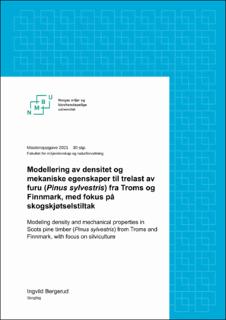| dc.contributor.advisor | Vestøl, Geir Isak | |
| dc.contributor.advisor | Høibø, Olav Albert | |
| dc.contributor.author | Bergerud, Ingvild | |
| dc.coverage.spatial | Norway | en_US |
| dc.date.accessioned | 2021-09-08T11:21:30Z | |
| dc.date.available | 2021-09-08T11:21:30Z | |
| dc.date.issued | 2021 | |
| dc.identifier.uri | https://hdl.handle.net/11250/2774611 | |
| dc.description.abstract | Med dagens høye avvirkning er det mye fokus på hvordan skogbruket kan øke volumtilveksten, og de mekaniske egenskapene er essensielle for bruken av trevirke i bærende konstruksjoner. En studie fra 1963 undersøkte styrkeegenskapene til furu (Pinus sylvestris) fra Nord-Norge. Resultatene viste den gang at trevirket fra området ikke egent seg som konstruksjonsvirke, og det ble frarådet å bruke trevirket til dette formålet. Målet med denne studien er å undersøke egenskapene til konstruksjonsvirke av furu fra Troms og Finnmark, med hensikt på å forklare variasjonen i virkesegenskaper relatert til skogskjøtselstiltak og forhold på voksestedet.
Trevirket ble samlet inn fra fire lokasjoner i Troms og Finnmark. Det ble samlet inn fra ti bestand, hvor det var 12 trær fra hvert bestand. Trærne ble kappet til stokker, før de til slutt ble skåret til plank. Totalt ble det skåret 650 planker av trevirket som ble samlet inn. Plankene ble deretter fraktet til NMBU for klimatisering og testing. E-modul, bøyefasthet og densitet ble testet i henhold til NS-EN 408. Det ble utført en varianskomponentanalyse av egenskapene, før variablene ble lagt inn og kjør ved bruk av lineær mikset modell.
Resultatene viste at densitet avtok med relativ høyde i trærne og med gjennomsnittlig årringbredde i brysthøyde. E-modul og bøyefasthet var negativt påvirket av relativ høyde, relativ diameter i brysthøyde, bonitet og temperatursum. E-modul og bøyefasthet positivt påvirket av densitet og negativ påvirket av kvist. Modellene basert på bestands-, tre- og stokkdata ble sammenlignet med modellene basert på densitet og kvistdata for E-modul og bøyefasthet for å undersøke hvilke som forklarte variasjonen i størst grad.
Effekten av skogskjøtselstiltak vil ikke være like stor i studieområdet som i andre deler av landet, grunnet lav bonitet og kort vekstsesong. Enkelte skjøtselstiltak kan likevel bidra med å bedre styrkeegenskapene. Eksempelvis vil rotasjonsalder og bestandstetthet være noe skogeier bør ta hensyn til ved avvirkning og etablering av bestand. Resultatene fra denne studien indikerer at egenskapene til konstruksjonsvirke av furu fra Troms og Finnmark ikke er så dårlig som tidligere antatt. En annen rapport fra prosjektet vil undersøke hvordan trevirket kan klassifiseres i henhold til NS-EN 338. | en_US |
| dc.description.abstract | With the high harvest in today’s forestry, there is a lot of focus on how forestry can increase volume growth, and the mechanical properties are essential for how the wood is used in loadbearing structures. A study from 1963 examined the strength properties of pine (Pinus sylvestris) from Northern-Norway. The results showed at the time that the wood from the area was not suitable as construction wood, and it was not recommended to use the wood for this purpose. The aim of this study is to investigate the properties of construction timber of pine from Troms and Finnmark, with the intention of explaining the variation in timber properties related to forest management measures and conditions at the growth site.
The wood was collected from four locations in Troms and Finnmark. It was collected from ten stands, where there were 12 trees from each stand. The trees were cut into logs, before they were finally cut into boards. A total of 650 boards were cut from the trees. The boards were then transported to NMBU for acclimatization and testing. Modul of elasticity, bending strength and density were tested according to NS-EN 408. A variance component analysis of the different properties was performed before the variables were entered and run using a linear mixed model.
The results showed that density decreased with relative height in the trees and with average annual ring width at breast height. Modules of elasticity and bending strength were negatively affected by relative height, relative diameter at breast height, site index and temperature sum. Modules of elasticity and bending strength were positively affected by density and negatively affected by knots. The models based on stand-, tree- and log data were compared to the models based on density and knot data for modules of elasticity and bending strength to investigate which explained the variation to the greatest extent.
The effect of forest management measures will not have as great an effect in the study area as in other parts of the country, due to low site index and a short growing season. Some management measures can nevertheless help improve the strength properties. For example, rotation age and stand density is something forest owners should consider when harvesting and establishing a stand. The results from this study indicate that the properties of construction timber of pine from Troms and Finnmark are not as poor as previously thought. Another report from the project will examine how the wood can be classified in accordance with NS-EN 338. | en_US |
| dc.language.iso | nob | en_US |
| dc.publisher | Norwegian University of Life Sciences, Ås | en_US |
| dc.rights | Attribution-NonCommercial-NoDerivatives 4.0 Internasjonal | * |
| dc.rights.uri | http://creativecommons.org/licenses/by-nc-nd/4.0/deed.no | * |
| dc.title | Modellering av densitet og mekaniske egenskaper til trelast av furu (Pinus sylvestris) fra Troms og Finnmark, med fokus på skogskjøtselstiltak | en_US |
| dc.title.alternative | Modeling density and mechanical properties in Scots pine timber (Pinus sylvestris) from Troms and Finnmark, with focus on silviculture | en_US |
| dc.type | Master thesis | en_US |
| dc.description.localcode | M-SF | en_US |

